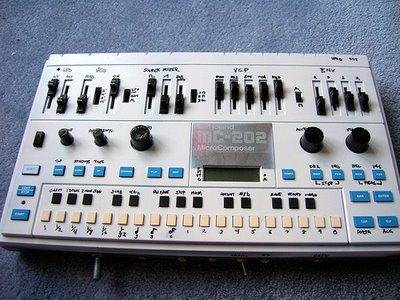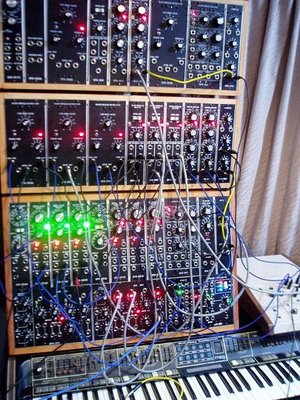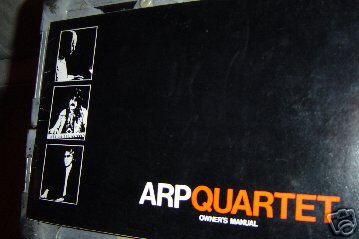 Title link takes you to shots pulled via this auction. Check out current bid. $910 and under 45 minutes to go as of this post. Crazy. You'll be able to get a brand new Little Phatty for about that soon.
Title link takes you to shots pulled via this auction. Check out current bid. $910 and under 45 minutes to go as of this post. Crazy. You'll be able to get a brand new Little Phatty for about that soon.
Sunday, November 26, 2006
Realistic Moog MG-1
 Title link takes you to shots pulled via this auction. Check out current bid. $910 and under 45 minutes to go as of this post. Crazy. You'll be able to get a brand new Little Phatty for about that soon.
Title link takes you to shots pulled via this auction. Check out current bid. $910 and under 45 minutes to go as of this post. Crazy. You'll be able to get a brand new Little Phatty for about that soon.
AvrX Goes Open Source
 Remember the AvrX? Mikael wrote in to let me know that sadly the kit will not be produced, however it will go open source.
Remember the AvrX? Mikael wrote in to let me know that sadly the kit will not be produced, however it will go open source."Nov 25, 2006
AvrX goes open source!
Over a year has passed since we published the first version of this site, and the kit is still not available. We have realized that we don't have the time to manage a kit. Instead we decided to release all sourcecode and information about AvrX as open source.
For some of you this is good news, but others waiting for the kit will be dissappointed. We are sorry if we have given you false hope of a kit, but at least this way anyone determined to build an AvrX can do so.
We will however sell the bare PCB. The wooden parts for the case can be manufactured by your local carpenter (or yourself), and the aluminum panels can be ordered from Schaeffer AG in europe or Front Panel Express in North America. All the other parts are available from companies like Elfa, Farnell and Mouser
As soon as we have cleaned up the sourcecode a little, we are going to put all the information on this website."
Custum White Face Roland MC-202
 This one in via d of glitched.org. Title link takes you to more shots.
This one in via d of glitched.org. Title link takes you to more shots."My MC-202 has the following modifications:
audio
+PWM osc out
+Sub osc mix out
+Audio in to VCF
+"Hidden" triangle osc out to VCF (with volume control via pot)
cv
+VCF in
+"Proper" CV/Gate in (bypasses the CPU)
modulation
+LFO "retrigger" CV in (I'm actually not sure what I did with this one, but when an audio signal is introduced and passes a certain threshold, the LFO seems to retrigger. It also makes the modulation range much wider [ex. pitch mod goes higher and lower]).
+"Hyperspeed" LFO: LFO frequency is in the audio domain (>300hz)
Here are some sound files:
- Pulse wave audio out to VCF CV in. Moderate-to-high resonance. Pitch mod.
- Pulse audio out to VCF CV in. Envelope triggered with high decay. High resonance, pitch is in 2' range, mod amount is raised.
- LFO is in "hyperspeed mode," modulating the VCF. Percussive pattern; demonstrates "hidden" triangle osc.
- Monomachine drum pattern through the 202's audio in (to VCF). Dry, then full-on.
These files were recorded by piping the 202 through the Monomachine, then to the Onyx 1220 firewire mixer @32bit/88.2khz. The small amount of reverb and delay is from the Monomachine."
Japanese Synth Gathering
 Title link takes you to a couple more shots on sequencer.de.
Title link takes you to a couple more shots on sequencer.de.Update via not even in the comments:
link1
link2
Faceplate cloning: link
Push them thru babelfish for gems like this: "Progress of production of moduration just a little is introduced the way of Hisashi before the that. Finally also panel production has begun trial manufacture in earnest. Below is VCO unit. Of course also that panel is in the midst of producing. The fact that these modules are settled in the enormous wooden framework has been produced in the pleasure."
Synclav.com on Fairlightcmi.com
 Thought this was odd. Title link takes you to Synclav.com, but the domain is fairlightcmi.com.
Thought this was odd. Title link takes you to Synclav.com, but the domain is fairlightcmi.com.Via Failed Muso.
MuseWave VSR (prototype)
 flickr by ALH84001
flickr by ALH84001Title link takes you to an image where you can mouse over each part for more info.
Saturday, November 25, 2006
ARP Manuals
 No title link, just three shots via this auction.
No title link, just three shots via this auction."3 ORIGINAL ARP SYNTHESIZER MANUALS - MANUALS FOR THE ARP QUARTET, ARP MINUS NOISE MIXER, ARP PIANO."
via brian comnes



There is also a decal here.
PAiA Modular
 Remember this giant PAiA modular? Here's another shot of it via plexus. Title link takes you to an even larger shot.
Remember this giant PAiA modular? Here's another shot of it via plexus. Title link takes you to an even larger shot.Update via plexus in the comments:i like to push the limits. and i cant justify nor afford aquiring a moog modular. so i thought "what about that paia modular stuff from the 70's?" i went shoping on ebay years ago and foung a farily large system. when i arrived, i tested it out. it sounded ok. there were some problems but with my intermediate knowledge of electronics i set out to turn this into a musical instrument. it was just a matter of repairing dead modules and replacing some parts that were essential to the quality of the audio they generate. indeed i turned it into a viable musical instrument.
you can hear it, being used live, at www.musicofsoftware.com in the sounds and the video section. all of the sequences are the paia modular through an eq and delay, that is in the video clips that have the modular being used.
so after i was able to make this into a musical instrument, and indeed people in the know were amazed at how good it sounded because they, like you, heard that paia stuff didnt sound very good. well in fact, thats not true.
in terms of circuit design they are not too bad. i wouldnt say as cheap as possible. certainly cost effective. my paia is as stable as my minimoog.
so check out the video clips and hear it for yourself.
after that i decided i wanted to collect these and restore them. so i began doing that. but now its time to liquidate part of the collection to help pay for a dsi polyevolver. i will keep a few paia 4700 cabinets and continue to use them in the studio and live."
Update: More shots on Music of Plexus
Mike's Synths
 Nice shot sent in by Mike Walters of Mystery Circuits. Also check out these previous posts featuring Mike and Mystery Circuits.
Nice shot sent in by Mike Walters of Mystery Circuits. Also check out these previous posts featuring Mike and Mystery Circuits.Update: The knob box on the top left is Mike's custom cased version of Ray Wilson's Sound Lab Mini-Synth
Stylinghead
PREVIOUS PAGE
NEXT PAGE
HOME













© Matrixsynth - All posts are presented here for informative, historical and educative purposes as applicable within fair use.
MATRIXSYNTH is supported by affiliate links that use cookies to track clickthroughs and sales. See the privacy policy for details.
MATRIXSYNTH - EVERYTHING SYNTH













© Matrixsynth - All posts are presented here for informative, historical and educative purposes as applicable within fair use.
MATRIXSYNTH is supported by affiliate links that use cookies to track clickthroughs and sales. See the privacy policy for details.
MATRIXSYNTH - EVERYTHING SYNTH

























